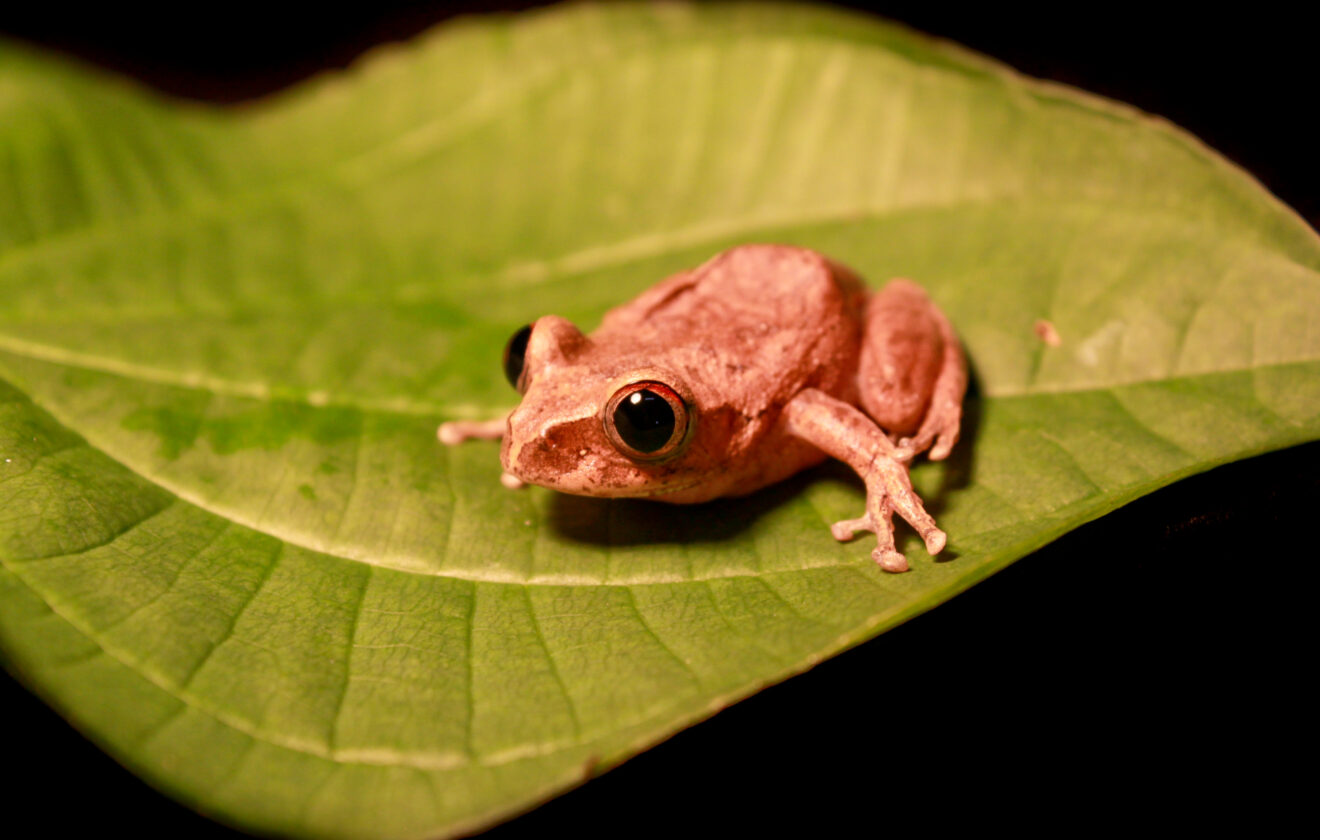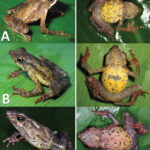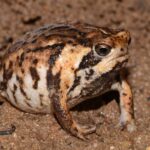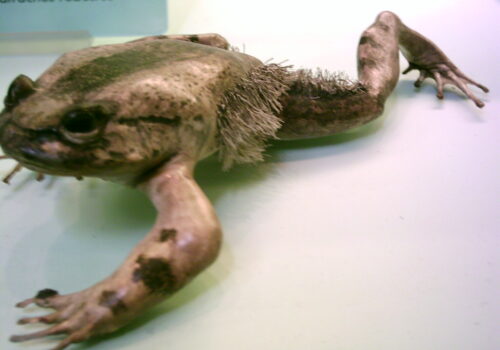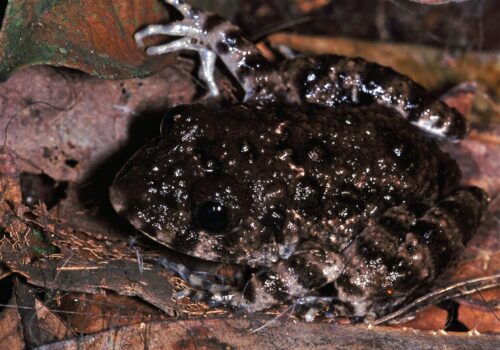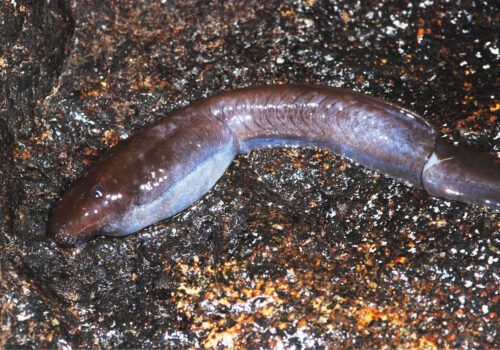The Gaboon Forest Treefrog (Leptopelis aubryi): Secrets of an Enigmatic Amphibian#
Under the heavy canopy of lush Central African rainforests, where mist hangs silently in the air and ancient trees stretch skyward, an inconspicuous master of camouflage leaps gracefully among emerald-green leaves. Known scientifically as Leptopelis aubryi, and commonly as the Gaboon Forest Treefrog, this remarkable amphibian carries with it tales of evolution, intricate behaviors, and distinct ecological importance. Although modestly sized and often overlooked in favor of more charismatic forest wildlife, the Gaboon Forest Treefrog exemplifies the hidden beauty and complexity of Africa’s biodiverse ecosystems.
From their peculiar nocturnal calls resonating through dense foliage to the vibrant shades that cloak their agile bodies, treefrogs like L. aubryi demonstrate nature’s astounding creativity and adaptation. Let’s journey deep into the heart of the Gaboon rainforests to illuminate the extraordinary existence of this captivating, often enigmatic, amphibian.
Taxonomy and Classification#
The Gaboon Forest Treefrog belongs to the family Arthroleptidae, one of Africa’s prominent frog families. Specifically within this family, it falls under the genus Leptopelis, a genus celebrated for its vibrant tree-dwelling frogs found throughout sub-Saharan Africa.
Leptopelis aubryi was first described scientifically in 1856, with its name honoring French collector Charles Eugène Aubry-Lecomte. Among its closest relatives are other colorful members of the genus, each adapted meticulously to their unique rainforest habitats. This genus stands out notably because each species within displays a fascinating array of adaptations to arboreal life and specific microhabitats.
Natural Habitat#
Nestled primarily in Central African countries like Gabon, Cameroon, Equatorial Guinea, Republic of Congo, and the Democratic Republic of Congo, the distribution of the Gaboon Forest Treefrog mirrors the lush borders of dense, evergreen tropical rainforests. These amphibians typically occupy a humid, vegetation-rich space ranging from lowland forests to mid-elevation slopes.
Enchantment in the Canopy#
The canopy layers, with towering trees draped in vines and epiphytes, provide the ideal setting for L. aubryi. They spend most of their adult lives amongst broad-leaved plants or in shrubs closer to the forest floor, where shadowy moisture and ample insect prey offer perfect living conditions.
The complex vertical structure of their forest home grants microenvironments ideal not just for shelter but for breeding. During the rainy season, temporary forest pools become vital breeding habitats, hosting eggs and developing tadpoles integral to the species’ life cycle.
Physical Characteristics#
Measuring approximately 4-6 centimeters in length at adulthood, the Gaboon Forest Treefrog is moderately sized and finely adapted to an arboreal existence. Its slender limbs end in broadened adhesive toe pads, allowing for effortless navigation across leaves and branches of their verdant rainforest dwellings. Long legs designed for powerful leaping enable swift escapes from predators, easily propelling the frog across impressive distances.
A Living Palette of Colors#
The skin of L. aubryi is a canvas of natural artistry, commonly vibrant green or beautifully mottled browns and greens, providing essential camouflage amid the dense foliage. Depending on mood, temperature, or stress, individuals may subtly adjust skin coloration and patterning, blending seamlessly into their surroundings. Their eyes are large and captivatingly expressive, often ornate with intricate patterns, granting unparalleled nocturnal vision to hunt insects under cover of darkness.
Behavior and Life Cycle#
Mysterious Melodies: Calls in the Night#
In the humid African twilight, the Gaboon forests reverberate with the rhythmic chorus of treefrog calls. Male L. aubryi produce a distinct, melodic yet moderately deep whistle, repeated at intervals to attract females for mating. For human listeners, their soothing songs create a hypnotic atmosphere that exemplifies the vibrant nocturnal character of the rainforest.
These vocalizations not only serve courtship purposes but also assert territory, an important part of their behavioral ecology. Male frogs often perch conspicuously within their domain, announcing their presence and vigor loudly and clearly.
From Trees to Pools: Breeding Habits#
When mating season arrives—typically aligning with seasonal rains—females lay gelatinous egg masses directly above temporary forest pools or shallow leaf-lined depressions that form during heavy rainfall. Eggs, numbering in the dozens to hundreds, are carefully positioned to drop into these pools upon hatching, where the aquatic tadpoles can safely develop.
Tadpoles of L. aubryi adopt an aquatic existence in shaded, secluded pools protected by overhanging vegetation. They rely on algae, detritus, and organic material for sustenance during this vulnerable yet transformative phase. Ultimately, metamorphosis grants them limbs, lungs, and terrestrial adaptability, allowing fresh juveniles to ascend into the arboreal realm where they will live out adulthood.
Ecological Role#
Vital Predators & Essential Prey#
The Gaboon Forest Treefrog occupies a central position within rainforest food webs, both predator and prey simultaneously. Adults voraciously consume various small insects—including moths, crickets, beetles, and flies—thus exerting important control on insect populations that could otherwise explosively proliferate.
However, treefrogs themselves help sustain a broad array of local ecosystem predators, such as snakes, birds, larger amphibians, and even arboreal mammals. Tadpoles provide crucial nutrition to aquatic predators, including dragonfly larvae and predatory beetles, underlining their significance from egg to adult.
Indicators of Forest Health#
Amphibians, including L. aubryi, serve as valuable bioindicators. Remarkably sensitive to environmental changes—from pollution and habitat destruction to climate shifts—these treefrogs offer scientists critical insights into the rainforest ecosystem’s overall health. Declines in frog populations are among the earliest visible symptoms of ecological strain, serving as alarms for necessary conservation action.
Threats and Conservation Status#
Currently classified as Least Concern by the International Union for Conservation of Nature (IUCN), Leptopelis aubryi maintains relatively stable populations within protected areas. Nevertheless, relentless pressures confront these amphibians—chief among them deforestation driven by agriculture, logging activities, and urbanization outside these safeguarded zones.
The Rising Impact of Climate Change#
Climate instability poses additional threats, altering precipitation patterns crucial to breeding cycles and tadpole development. Additionally, emerging infectious diseases such as chytridiomycosis, linked to global warming and human movement, increasingly threaten amphibians worldwide.
Hope Through Conservation Efforts#
Conservation organizations and researchers are working diligently in Central African rainforest habitats to monitor amphibian diversity and health, designate critical protected areas, and conduct environmental education programs highlighting amphibians’ key roles and vulnerabilities. For the Gaboon Forest Treefrog, these international and regional conservation efforts could spell the difference between a thriving population and heartbreaking declines.
Cultural and Scientific Significance#
While L. aubryi may not generally figure prominently in African folklore or traditional customs, frogs carry powerful symbolic meaning globally as heralds of environmental harmony and regeneration. Scientifically, treefrogs like L. aubryi have contributed significantly to herpetological research on ecological roles, bioindicators, as well as studies of skin toxins and their potential medicinal applications.
Conclusion#
Leptopelis aubryi, the Gaboon Forest Treefrog, exemplifies the delicate beauty and ecological richness intertwined within Africa’s rainforests. While navigating their lush world unobtrusively, these amphibians inform us profoundly about habitat wellbeing and biodiversity integrity. Their soft whistles echo more than mating calls—they call urgently for humanity’s increased awareness, sensitivity, and stewardship toward fragile ecosystems at home across our shared planet.
Conservation begins with knowledge and appreciation; learning more about remarkable amphibians like L. aubryi opens doors to meaningful engagement and lasting solutions. Let’s ensure their vibrant songs continue resonating for generations.








